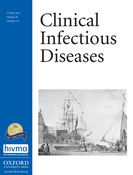Clin Infect Dis:三种社交活动或增加大学生患脑膜炎风险
| 导读 |
住在宿舍楼增加了大学生罹患脑膜炎球菌病的风险。在引进四价脑膜炎球菌疫苗之前,美国大学校园里爆发的脑膜炎球菌病主要是由C群脑膜炎球菌引起的。随着四价疫苗的接种,C群脑膜炎球菌病得到有效控制,而这一人群中由B群脑膜炎球菌所致疾病的比例却逐渐上升。由于美国缺少获得许可的B群脑膜炎球菌疫苗,因此公共卫生对B群脑膜炎球菌爆发的应对受限。基于上述情况,来自美国... |

住在宿舍楼增加了大学生罹患脑膜炎球菌病的风险。在引进四价脑膜炎球菌疫苗之前,美国大学校园里爆发的脑膜炎球菌病主要是由C群脑膜炎球菌引起的。随着四价疫苗的接种,C群脑膜炎球菌病得到有效控制,而这一人群中由B群脑膜炎球菌所致疾病的比例却逐渐上升。由于美国缺少获得许可的B群脑膜炎球菌疫苗,因此公共卫生对B群脑膜炎球菌爆发的应对受限。基于上述情况,来自美国亚特兰大疾病控制和预防中心的Sema Mandal等人展开一项研究,研究结果在线发表于2013年4月17日的《临床感染性疾病》(Clinical Infectious Diseases)杂志上。作者发现,A大学脑膜炎的爆发与新型B群脑膜炎球菌菌株(CC269)相关,危险因素调查表明增加社交活动会加大患病风险。
在2010年3月,作者对美国某大学(A大学)相关的B群脑膜炎球菌病的持续爆发情况进行了研究。除确定病例之外,研究人员也对分离株实施了分子分型以表征这一爆发的特征。他们进行了病例对照配对研究,以确定B群脑膜炎球菌病的危险因素。研究人员为每例病患随机选择了5例年级相匹配的对照者。参试者需完成一份危险因素调查问卷。最终,研究人员应用条件逻辑回归对数据进行分析。
研究结果如下,在2008年1月至2010年11月期间,从A大学大学生群体(10例)或相关人员(3例)中鉴定出13例脑膜炎球菌病例(7例确诊病例,4例疑似病例,以及2例可疑病例)。一名学生死亡。10例被确定为B群脑膜炎球菌。来自6例确诊病例的分离株具有难以区分的脉冲电场凝胶电泳模式,属于序列型ST-269,克隆株(CC)269。与脑膜炎显著相关的危险因素有:兄弟会或姐妹盟成员(匹配比值比(mOR):15.0;p=0.03),多个亲吻伴侣(kissing partner)(mOR:13.7;p=0.03)以及去酒吧(mOR:8.1;p=0.04)。
研究发现,A大学脑膜炎球菌病的爆发归咎于一种新型的B群脑膜炎球菌菌株(CC269),危险因素调查表明增加社交活动(兄弟会或姐妹盟成员、多个亲吻伴侣、去酒吧)会加大患病风险。当前B群脑膜炎球菌疫苗正被考虑许可,了解大学和其他环境中B群脑膜炎球菌的传播有助于为疫苗的使用提供信息。
原文链接:
Prolonged university outbreak of meningococcal disease associated with a serogroup B strain rarely seen in the US.
Background
College students living in residential halls are at increased risk of meningococcal disease. Unlike for serogroups prevented by quadrivalent meningococcal vaccines, public health response to outbreaks of serogroup B meningococcal disease is limited by lack of a US licensed vaccine.
Methods
In March 2010 we investigated a prolonged outbreak of serogroup B disease associated with a university. In addition to case ascertainment, molecular typing of isolates was performed to characterize the outbreak. We conducted a matched case-control study to examine risk factors for serogroup B disease. Five controls per case, matched by college year, were randomly selected. Participants completed a risk factor questionnaire. Data were analyzed using conditional logistic regression.
Results
Between January 2008 and November 2010, we identified 13 meningococcal disease cases (seven confirmed, four probable, and two suspected) among university students (ten) or university-linked persons (three). One student died. Ten cases were determined to be serogroup B. Isolates from six confirmed cases had an indistinguishable pulse-field gel electrophoresis pattern and belonged to sequence type ST-269, clonal complex 269. Factors significantly associated with disease were Greek Society membership (matched odds ratio [mOR] 15.0; p=0.03), >1 kissing partner (mOR 13.7; p=0.03) and attending bars (mOR 8.1; p=0.04).
Conclusions
The outbreak was associated with a novel serogroup B strain (CC269) and risk factors indicative of increased social mixing. Control measures were appropriate but limited by lack of vaccine. Understanding serogroup B transmission in college and other settings will help inform use of serogroup B vaccines currently under consideration for licensure.
关注转化医学网
【转化医学网 新浪微博:@转化医学网】
【转化医学网 公众微信账号:zhuanhuayixue】或扫描二维码关注微信

来源:丁香园
 腾讯登录
腾讯登录
还没有人评论,赶快抢个沙发